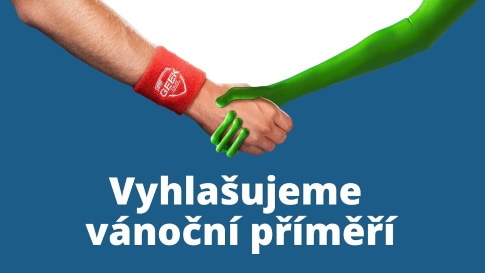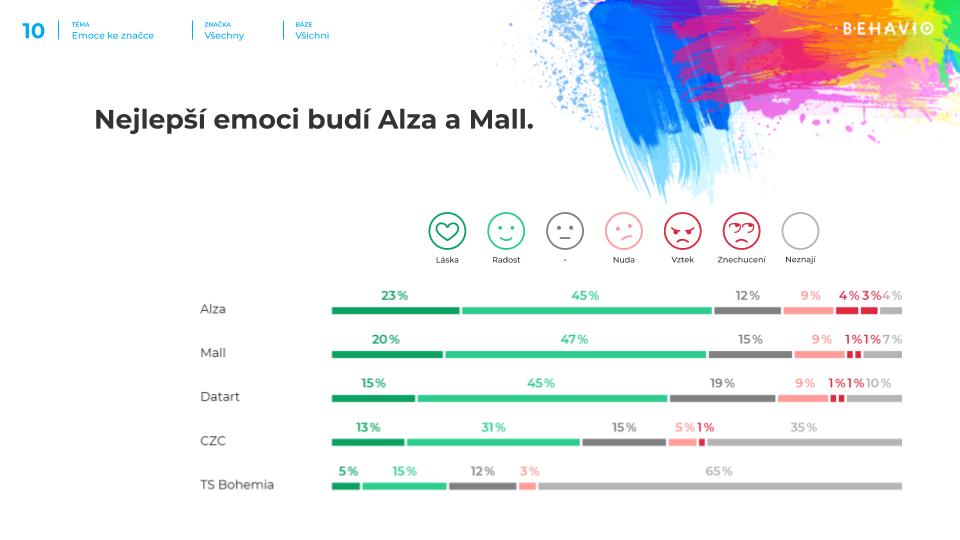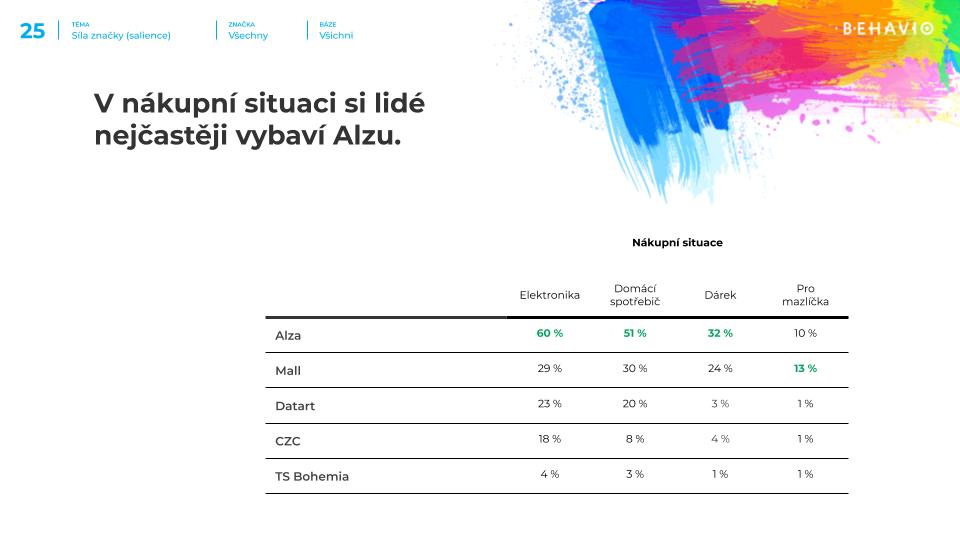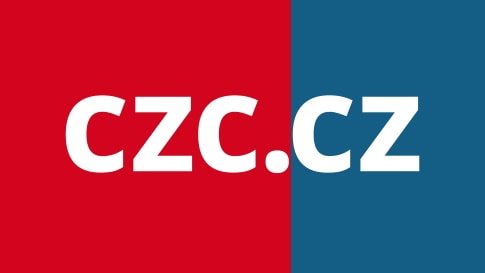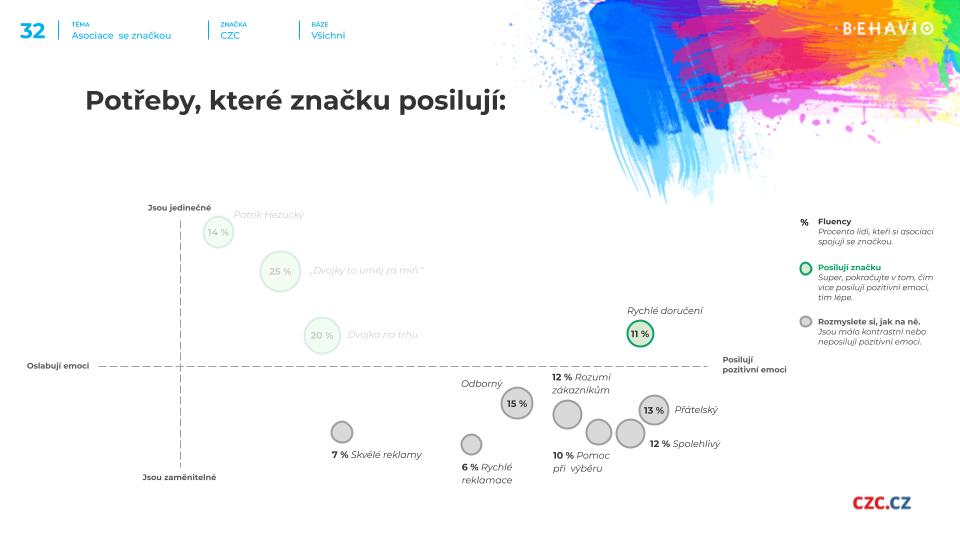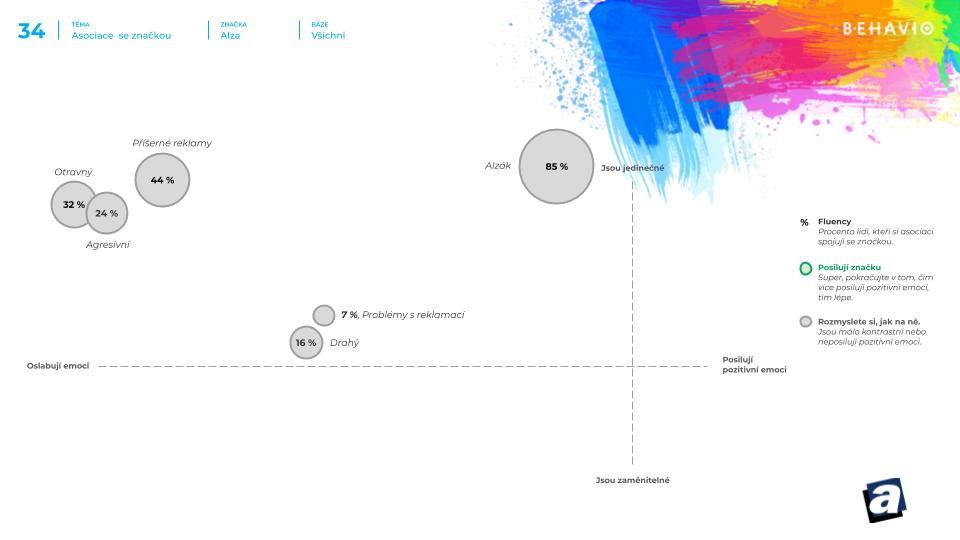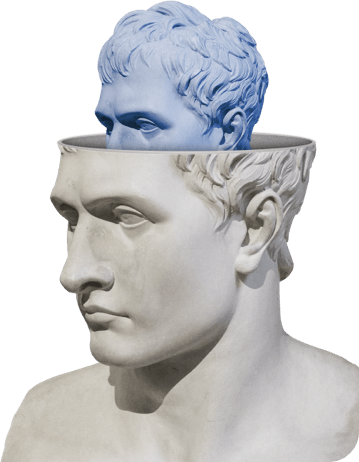What are the strenghts of online brands and how can we measure them?
-
 Jiri Boudal
Jiri Boudal
- 1. March 2022
Rationality finds its way into our decision-making process a lot less than we would expect. Which explains why we’re interested in the behavioural principles and indicators that influence customer’s decision in the subconscious mind on where to shop.
How can you measure the subconscious?
With a classic questionnaire? Thta will be quite difficult.. A questionnaire communicates with our consciousness and attempts to somehow peek into the subconscious, which turns out to be an unfortunate combination. If someone was to ask us, “How likely are you to recommend our company to your business partners on a scale of 1 to 10?”, our subconscious simply isn’t able to come up with an answer. No such question exists in its manual. Therefore, the subconscious mind just translates the complex sentence into something it can understand.
When we are asked a difficult question, we usually unknowingly answer some simpler question instead.
Daniel Kahneman
The problem is, however, that everyone answers something a bit different. One of us might imagine their inaccessible business partner who doesn’t care about them enough to even give them the time of day. Another one of us might be lucky when it comes to business partners. They can often be seen spending time together and exchanging tips about who knows what over a couple beers. Either way, the result is nothing more than a information pell-mell. For this reason, when designing our research, we strive to speak in a way that people (and their subconscious) can understand.
How can a researcher come to understand the subconscious
We go to meet the brain halfway and not bother our respondents with unnecessary time spent thinking. To achieve this, we use several basic procedures: Respondents only have a few seconds to complete each task, meaning they have to make decisions quickly and spontaneously. In our research, people assign, recognize, and select products the same way they do in real life. We ask direct questions regarding the simple things that remain hidden in the background of the stilted formulation. One example of a question might be “How do you feel about our company?”. We also often show different variations to individual people and observe how their decisions differ. On average, our research doesn’t take that long, and after a certain amount of time, right as people’s attention begins to wane, we throw in a survey with a funny gif to help them relax. By the way, take a look at this cat before we move on.
In order for us to present such colourful and simple tests, we had to program our own research panel. It is called Trendaro, and we currently have over 20 thousand people registered on the site. These people regularly take part in our research, and, according to them, it’s pretty entertaining.
I already have some experience with online surveys, but your panel came as a pleasant surprise. I enjoyed the amazing design of the site, the graphics, and the actual questionnaires that are quite understandable, often funny, and imaginative.
anonymous Trendaro user
By now you can see that you more or less know why and how we measure, so let’s take a look at the specific results of three Czech e-shops: Alza, Mall, and CZC. First, we will compare them together, then we will go through each brand on its own to find their weak and strong suits. To finish off, we have a littler treat for you: We will use the same data to show you the difference between what we are able to discover using our methods and what conventional questionnaires achieve.
Free for all
Emotion
The brain often makes bets on what it will like at first, with no need for deeper contemplation. It attempts to speed up our decision-making process. It wants to make the experience cost less, make it more energy efficient. Therefore, the better emotion a brand is able to instill in us, the more that brand will come to mind when we’re in a purchasing situation. This then goes to increase the chances that we will actually spend money on that brand’s products. It is for this very reason we track emotions.
If we were only to take emotions into account, Alza and Mall would come out looking the same. There are, however, other indicators that play a role in distinguishing the two.
Salience
Also known as the moment when you spontaneously recall a brand in a shopping situation. This is the indicator that says: This brand automatically comes to mind anytime I need a certain kind of goods or services.
It’s here that Alza takes a significant step forward. Alza beats out its competition, especially in the world of electronics, which is closer to the real market distribution and sales numbers than the previous order, which was based on emotions.
The effect of easy processing and contrast
Dozens of associations, symbols, and previously-mentioned emotions represent a brand in our minds (the effect of a positive feeling). The easier the brand is to digest (easy processing effect) and the more unique and varied it is from the competition (contrast effect), the better.
Brand symbols
A symbol can be practically anything: a shape, a colour, a character, a melody, a slogan, a logo, packaging… For every brand, symbols are increasingly important, as our subconscious (the place where 95% of purchasing decisions play out) doesn’t think using mathematics, words, or logistical arguments. Here, the language of symbols is doing the talking. And for this reason, a strong brand needs to know how to speak this language fluently.
The customer needs to know within the fraction of a second that a certain brand is going to meet a certain need the best. In the best case scenario, CZC isn’t going to say, “We are the best at everything”, rather it will try to exhibit this fact via a symbol. Maybe with a likeable geek standing at the counter, for example. CZC then needs to sneak this symbol into people’s subconscious by showing it in ads and on posters. This needs to go on until that symbol is nested well into the recesses of our brain. Only then will the customer say: I want to buy a new phone. My old phone is a Nokia 3310, so I’m probably going to need some assistance… and BAM! They’re already punching CZC into their web browser.
Jirka spoke about how functioning symbols can be made at the Data Breakfast workshop. We will include the recording here in case anyone would like to study it on their own.
When it comes to recalling symbols, Alza is unequivocally in the lead; 85% of Czechs are able to identify its mascot. Only 14% of people remember Patrik Hezucký as being connected to CZC, and in absolute last place is Mall with Leoš Mareš, whom only 4% of people are able to recall. The issue here could be that the moderator is such a distinct brand in and of himself that people unknowingly match the brand to him, instead of the other way around. Just because a celebrity is well-known, prestigious, beloved, or great in any way, doesn’t mean that their engagement is a good investment, nor that the brand’s image will actually improve.
Emotions towards brand symbols
After a test was completed regarding the popularity of the symbols, the order immediately flipped. 43% of people can’t stand Alzák, whereas the two moderators from the radio station Evropa 2 are greeted with a warmer response. Despite this reality, as we will show you momentarily, Alzák still proves to be a better symbol overall when compared with his celebrity rivals. Although, we must say, this is an extremely interesting exception to the rules.

Slogan competition
Once again, Alza is well ahead of its competitors. Most of the population is familiar with their slogan “masakr cen”. (Did you read the slogan in Alzák’s voice, per chance?). The slogan “Dvojky to uměj za míň” from CZD has achieved decent reach in light of the brand having recently come onto the market. Mall, however, suffers from a large handicap in this area. Their slogans are too general and difficult to remember. Stating “we meet your needs” and “sales-mania” are things even your local grocer can promise, which is something that’s been proven in the data – more people match these slogans to other brands than to the correct one.
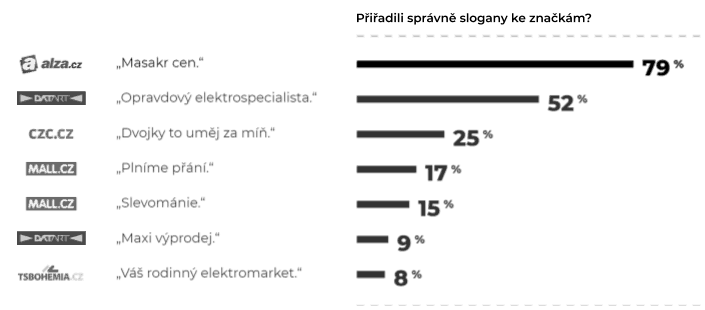
The individual players
Now let’s get into the details and take a look at the pluses and minuses of each individual e-shop as a brand. We will be interested in the following: which symbols in their communication represent which needs? And are these symbols helping us to like the brand more?

MALL's symbols
There are three symbols that Mall is working with. Two slogans and one celebrity, all of which are relatively weak. “We meet your needs” is matched to the brand by only 17% of people, whereas only 15% of people correctly matched “sales-mania”, and poor Leoš comes in last at 4%. Practically speaking, these symbols are not improving the positive emotions felt towards the brand. In this category, their effectiveness is basically zero. Hiring Leoš Mareš definitely wasn’t cheap, and his involvement actually mildly weakened the brand.
What MALL needs
We selected a general package of needs that customers feel when it comes to e-shops. It’s here we discovered the following: Which needs people pair with which brands? Which brands are they helping and which are they hurting? Are they unique?
When searching for new symbols, Mall should focus on these needs and think how best to translate them into the language of the subconscious.
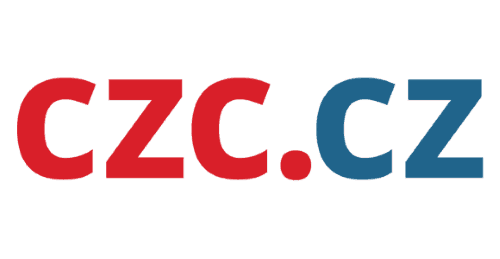
CZC's symbols
CZC cunningly appropriated its number two position on the market (one fifth of people associate this position with the brand). Judging by the sales numbers and salience data, however, in reality they are actually in “fourth” place. CZC gives the impression that the customer can go to the huge and well-established Alza, however, Alza doesn’t even have to try too hard to get its customers, nor does it need a new market. The customers just come on their own. However, “second place” still has something to prove and this symbol jumps into our mind, hiding the message: ““Dvojky to uměj za míň” (“Second place does it cheaper”). All this, together with Patrik Hezucký, improves the emotions felt towards the brand, and working as the number two store functions beautifully when it comes to contrasting with the competition.
A common bad habit for advertisers is trying to make a mascot similar to their successful competition’s (e.g. trying to use something like Alzák for yourself. Something like Mallák? Maybe Cézecák?). But this is in no way the right way to go. The best character competes the best on a field all its own. Not by imitation, but rather by using a symbol from another category. So, making yourself #2 against Alza’s mascot (Alzák), for instance, could work.
What CZC needs
Here we see how even a smaller brand can survive amongst the giants who have occupied their key needs. The best way to do this is to make your brand come off as a likable little corner store, where the patient shop assistant is always ready to lend a helpful hand.
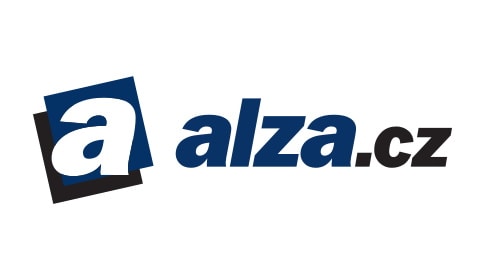
Alza's symbols
Alza’s status as #1 on the market helps a lot (40% of people ascribe to this belief). All of us like make choices in such a way that we can identify with the successful ones. We like to be part of the winning team, a fact that other behavioural findings have also confirmed.
“Masakr cen” (“Price massacre”) is a slogan that the brand has repeated so persistently and for so long that it has written itself into the memory of a majority of Czechs. This is a great outcome, however, Alza also needs to keep in mind that this effect wanes with time, and it’s doing nothing to bring in new customers. Pretty much everyone (79% of people) are familiar with the slogan, so there’s no need to waste any more money supporting it further.
Another functional symbol is “šikovná aplikace” (“smart application”), which only 17% of people are familiar with. This slogan conceals the information that the brand is innovative, it’s thinking about its customers, and it provides smart solutions.
Alright, but where is that damned Alzák??
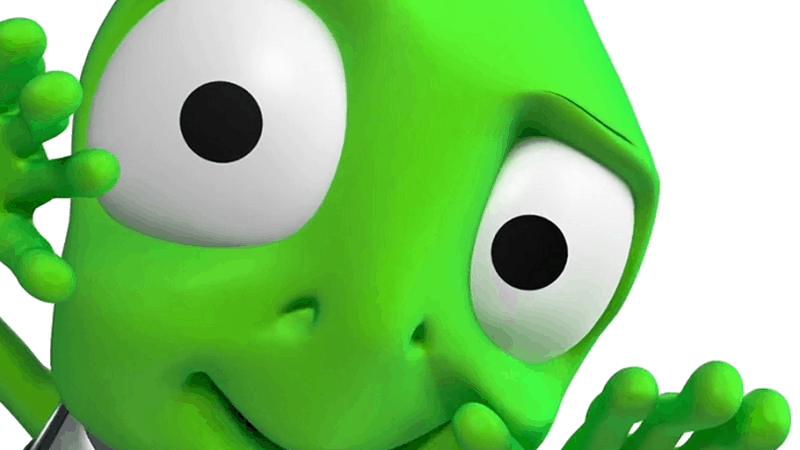
He’s on the completely opposite side of the scale. Although, he is unique within the world of symbols, he is the cause of weakening the positive emotion felt towards the brand. Some people would even say, “I like Alza a little bit less because I’m familiar with Alzák.” At first glance, it may seem that he is harmful to the brand. However, this is not true. In this unique case, Alzák works abnormally, but well. What he takes away in the way of emotion towards the brand, he makes up for in the contrast effect and easy processing. There’s no chance we will ever confuse him with another symbol, and we recognize him the second we see him on a billboard, even when we only catch him as a little green smudge out of our peripheral vision when driving by. In any case, Alza is brave here. It’s definitely an original, bold move to beat your customers repeatedly over the head with a persistent, loud-mouthed little alien. Either way, any less strong brand wouldn’t be able to use him.
Alza's needs
Although Alza meets a large number of needs, it’s only created a few successful symbols. The “price massacre” slogan tells us we’re buying cheap goods. Alzák isn’t the symbol of any specific need. He doesn’t represent reliability, or a good offer, or anything of the sort. Therefore, the brand definitely has a large space to fill when it comes to developing symbols. We recommend that Alza continues using Alzák, but that it also focus on how it can symbolically build on the needs of its customers.
Everything included in this article, plus more information, can be found in the video presentation put on by our Director of Research, Vojta.
A little something you might find interesting
By now you know everything we’ve discovered about brands by using our methods. Everything should be three-dimensional for you now, tangible. You now know their weaknesses, you know what makes them different. Out of interest (and curiosity), we attempted to also measure Mall and Alza using the conventional method: “How friendly would you rank this brand on a scale from x to y?”. You can see the results below. Wouldn’t you say both competitors come off as rather interchangeable? Would you be able to make any business decisions based off these numbers? Or come up with a successful campaign?

